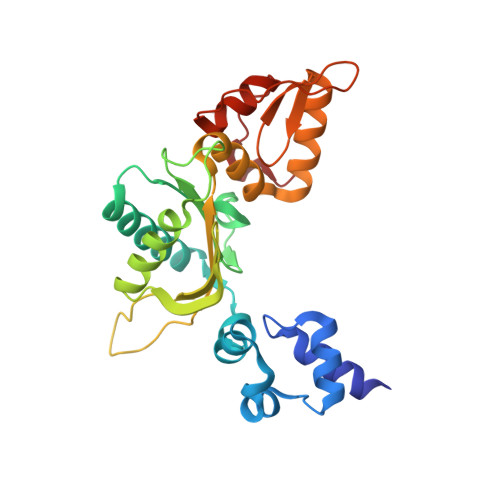Pol beta /XRCC1 heterodimerization dictates DNA damage recognition and basal Pol beta protein levels without interfering with mouse viability or fertility.
Koczor, C.A., Thompson, M.K., Sharma, N., Prakash, A., Sobol, R.W.(2023) DNA Repair (Amst) 123: 103452-103452
- PubMed: 36702010
- DOI: https://doi.org/10.1016/j.dnarep.2023.103452
- Primary Citation of Related Structures:
8E10, 8E11 - PubMed Abstract:
DNA Polymerase β (Polβ) performs two critical enzymatic steps during base excision repair (BER) - gap filling (nucleotidyl transferase activity) and gap tailoring (dRP lyase activity). X-ray repair cross complementing 1 (XRCC1) facilitates the recruitment of Polβ to sites of DNA damage through an evolutionarily conserved Polβ/XRCC1 interaction interface, the V303 loop. While previous work describes the importance of the Polβ/XRCC1 interaction for human Polβ protein stability and recruitment to sites of DNA damage, the impact of disrupting the Polβ/XRCC1 interface on animal viability, physiology, and fertility is unknown. Here, we characterized the effect of disrupting Polβ/XRCC1 heterodimerization in mice and mouse cells by complimentary approaches. First, we demonstrate, via laser micro-irradiation, that mouse Polβ amino acid residues L301 and V303 are critical to facilitating Polβ recruitment to sites of DNA damage. Next, we solved the crystal structures of mouse wild type Polβ and a mutant protein harboring alterations in residues L301 and V303 (L301R/V303R). Our structural analyses suggest that Polβ amino acid residue V303 plays a role in maintaining an interaction with the oxidized form of XRCC1. Finally, we created CRISPR/Cas9-modified Polb mice with homozygous L301R/V303R mutations (Polb L301R-V303R/L301R-V303R ) that are fertile yet exhibit 15% reduced body weight at 17 weeks of age, as compared to heterozygous mice. Fibroblasts derived from Polb L301R-V303R/L301R-V303R mice demonstrate that mutation of mouse Polβ's XRCC1 interaction domain leads to an ∼85% decrease in Polβ protein levels. In all, these studies are consistent with a role for the oxidized form of XRCC1 in providing stability to the Polβ protein through Polβ/XRCC1 heterodimer formation.
- Mitchell Cancer Institute, University of South Alabama, Mobile, AL 36604, USA; Department of Pharmacology, College of Medicine, University of South Alabama, Mobile, AL 36688, USA.
Organizational Affiliation:

















